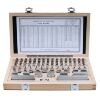barnfrog
Member
Stopped at an LGS the other day to see if they had a couple things I've been looking for. They didn't, but while I was poking around I saw a used set of Lyman dial calipers. I've been using a pretty cheap set of digital, and the price was right so I bought them. They're not the quality of Starrette obviously, but I think they're an upgrade for me.
My question to those of you who use dial calipers is this: when you are taking a reading do you estimate tenths between the hash marks, or just round to the nearest whole/half? I seem to recall in junior high science class we were taught to estimate in between the marks, but even if that's true I'm not sure how much value there is in trying to estimate to the nearest 0.0001" instead of the nearest 0.0005". I can't adjust my dies to the nearest 0.0001" so what would be the point?
Curious what others do and what their reasoning is.
My question to those of you who use dial calipers is this: when you are taking a reading do you estimate tenths between the hash marks, or just round to the nearest whole/half? I seem to recall in junior high science class we were taught to estimate in between the marks, but even if that's true I'm not sure how much value there is in trying to estimate to the nearest 0.0001" instead of the nearest 0.0005". I can't adjust my dies to the nearest 0.0001" so what would be the point?
Curious what others do and what their reasoning is.







